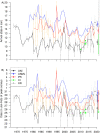Estimating population size when individuals are asynchronous: A model illustrated with northern elephant seal breeding colonies
- PMID: 35073340
- PMCID: PMC8786122
- DOI: 10.1371/journal.pone.0262214
Estimating population size when individuals are asynchronous: A model illustrated with northern elephant seal breeding colonies
Abstract
Our aim was to develop a method for estimating the number of animals using a single site in an asynchronous species, meaning that not all animals are present at once so that no one count captures the entire population. This is a common problem in seasonal breeders, and in northern elephant seals, we have a model for quantifying asynchrony at the Año Nuevo colony. Here we test the model at several additional colonies having many years of observations and demonstrate how it can account for animals not present on any one day. This leads to correction factors that yield total population from any single count throughout a season. At seven colonies in California for which we had many years of counts of northern elephant seals, we found that female arrival date varied < 2 days between years within sites and by < 5 days between sites. As a result, the correction factor for any one day was consistent, and at each colony, multiplying a female count between 26 and 30 Jan by 1.15 yielded an estimate of total population size that minimized error. This provides a method for estimating the female population size at colonies not yet studied. Our method can produce population estimates with minimal expenditure of time and resources and will be applicable to many seasonal species with asynchronous breeding phenology, particularly colonial birds and other pinnipeds. In elephant seals, it will facilitate monitoring the population over its entire range.
Conflict of interest statement
The authors have declared that no competing interests exist.
Figures




References
-
- Frederick PC, Heath JA, Bennetts R, Hafner H. Estimating nests not present at the time of breeding surveys: an important consideration in assessing nesting populations. Journal of Field Ornithology. 2006;77(2):212–219. doi: 10.1111/j.1557-9263.2006.00043.x - DOI
-
- Piazza BP, Wright VL. Within-season Nest Persistence in Large Wading Bird Rookeries. 2004;27(3):362–367.
-
- Condit R, Le Boeuf BJ, Morris PA, Sylvan M. Estimating population size in asynchronous aggregations: a Bayesian approach and test with elephant seal censuses. Marine Mammal Science. 2007;23(4):834–855. doi: 10.1111/j.1748-7692.2007.00141.x - DOI
-
- Le Boeuf BJ, Laws RM, editors. Elephant Seals: Population Ecology, Behavior, and Physiology. University of California Press; 1994.
MeSH terms
LinkOut - more resources
Full Text Sources
Research Materials

